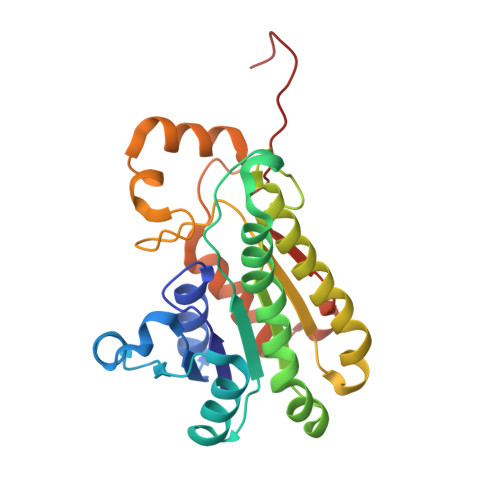Structural Basis for the Enantioselectivity of an Epoxide Ring Opening Reaction Catalyzed by Halo Alcohol Dehalogenase HheC.
de Jong, R.M., Tiesinga, J.J.W., Villa, A., Tang, L., Janssen, D.B., Dijkstra, B.W.(2005) J Am Chem Soc 127: 13338-13343
- PubMed: 16173767
- DOI: https://doi.org/10.1021/ja0531733
- Primary Citation of Related Structures:
1ZMT, 1ZO8 - PubMed Abstract:
Halo alcohol dehalogenase HheC catalyzes the highly enantioselective dehalogenation of vicinal halo alcohols to epoxides, as well as the reverse reaction, the enantioselective and beta-regioselective nucleophilic ring opening of epoxides by pseudo-halides such as azide and cyanide. To investigate this latter reaction, we determined X-ray structures of complexes of HheC with the favored and unfavored enantiomers of para-nitrostyrene oxide. The aromatic parts of the two enantiomers bind in a very similar way, but the epoxide ring of the unfavored (S)-enantiomer binds in a nonproductive inverted manner, with the epoxide oxygen and Cbeta atom positions interchanged with respect to those of the favored (R)-enantiomer. The calculated difference in relative Gibbs binding energy is in agreement with the observed loss of a single hydrogen bond in the S bound state with respect to the R bound state. Our results indicate that it is the nonproductive binding of the unfavored (S)-enantiomer, rather than the difference in affinity for the two enantiomers, that allows HheC to catalyze the azide-mediated ring opening of para-nitrostyrene oxide with high enantioselectivity. This work represents a rare opportunity to explain the enantioselectivity of an enzymatic reaction by comparison of crystallographic data on the binding of both the favored and unfavored enantiomers.
Organizational Affiliation:
Department of Biophysical Chemistry, University of Groningen, Nijenborgh 4, NL-9747 AG Groningen, The Netherlands.















